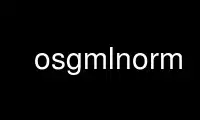
This is the command osgmlnorm that can be run in the OnWorks free hosting provider using one of our multiple free online workstations such as Ubuntu Online, Fedora Online, Windows online emulator or MAC OS online emulator
PROGRAM:
NAME
osgmlnorm - An SGML/XML document normalizer
SYNOPSIS
osgmlnorm [-CdeghmnrRvx] [-alinktype] [-Aarchitecture] [-bbctf] [-ccatalog]
[-Ddirectory...] [-Emax_errors...] [-iname...] [-fname...] [-wwarning...]
[sysid...]
DESCRIPTION
osgmlnorm prints on the standard output a normalized document instance for the SGML
document contained in the concatenation of the entities with system identifiers
When the normalized instance is prefixed with the original SGML declaration and prolog, it
will have the same ESIS as the original SGML document, with the following exceptions:
* The output of osgmlnorm does not protect against the recognition of short reference
delimiters, so any USEMAP declarations must be removed from the DTD.
* The normalized instance will use the reference delimiters, even if the original instance
did not.
* If marked sections are included in the output using the -m option, the reference
reserved names will be used for the status keywords even if the original instance did not.
* Any ESIS information relating to the SGML LINK feature will be lost.
The normalized instance will not use any markup minimization features except that:
* Any attributes that were not specified in the original instance will not be included in
the normalized instance. (Current attributes will be included.)
* If the declared value of an attribute was a name token group, and a value was specified
that was the same as the name of the attribute, then the attribute name and value
indicator will be omitted. For example, with HTML osgmlnorm would output <DL COMPACT>
rather than <DL COMPACT="COMPACT">
Part of an SGML System Conforming to International Standard ISO 8879 -- Standard
Generalized Markup Language. An SGML Extended Facilities system conforming to Annex A of
International Standard ISO/IEC 10744 -- Hypermedia/Time-based Structuring Language.
The following options are available:
-aname, --activate=name
Make doctype or linktype name active.
-Aarchitecture, --architecture=architecture
Parse with respect to architecture architecture.
-bbctf, --bctf=bctf
Use the BCTF with name bctf for output.
-csysid, --catalog=sysid
Map public identifiers and entity names to system identifiers using the catalog entry
file whose system identifier is sysid.
-C, --catalogs
This has the same effect as in onsgmls(1).
-d, --dtd
Output a document type declaration with the same external identifier as the input
document, and with no internal declaration subset. No check is performed that the
document instance is valid with respect to this DTD.
-Ddirectory, --directory=directory
Search directory for files specified in system identifiers.
This has the same effect as in onsgmls(1).
-e, --open-entities
Describe open entities in error messages.
--error-numbers
Show error numbers in error messages.
-h, --help
Display a help text and exit.
-iname, --include=name
This has the same effect as in onsgmls(1).
-m, --marked-sections
Output any marked sections that were in the input document instance.
-n, --comments
Output any comments that were in the input document instance.
-r, --raw
Raw output. Don't perform any conversion on RSs and REs when printing the entity. The
entity would typically have the storage manager attribute records=asis.
-R, --restricted
This has the same effect as in onsgmls(1).
-v, --version
Print the version number.
-wtype
Control warnings and errors according to type. This has the same effect as in
onsgmls(1).
Use osgmlnorm online using onworks.net services
